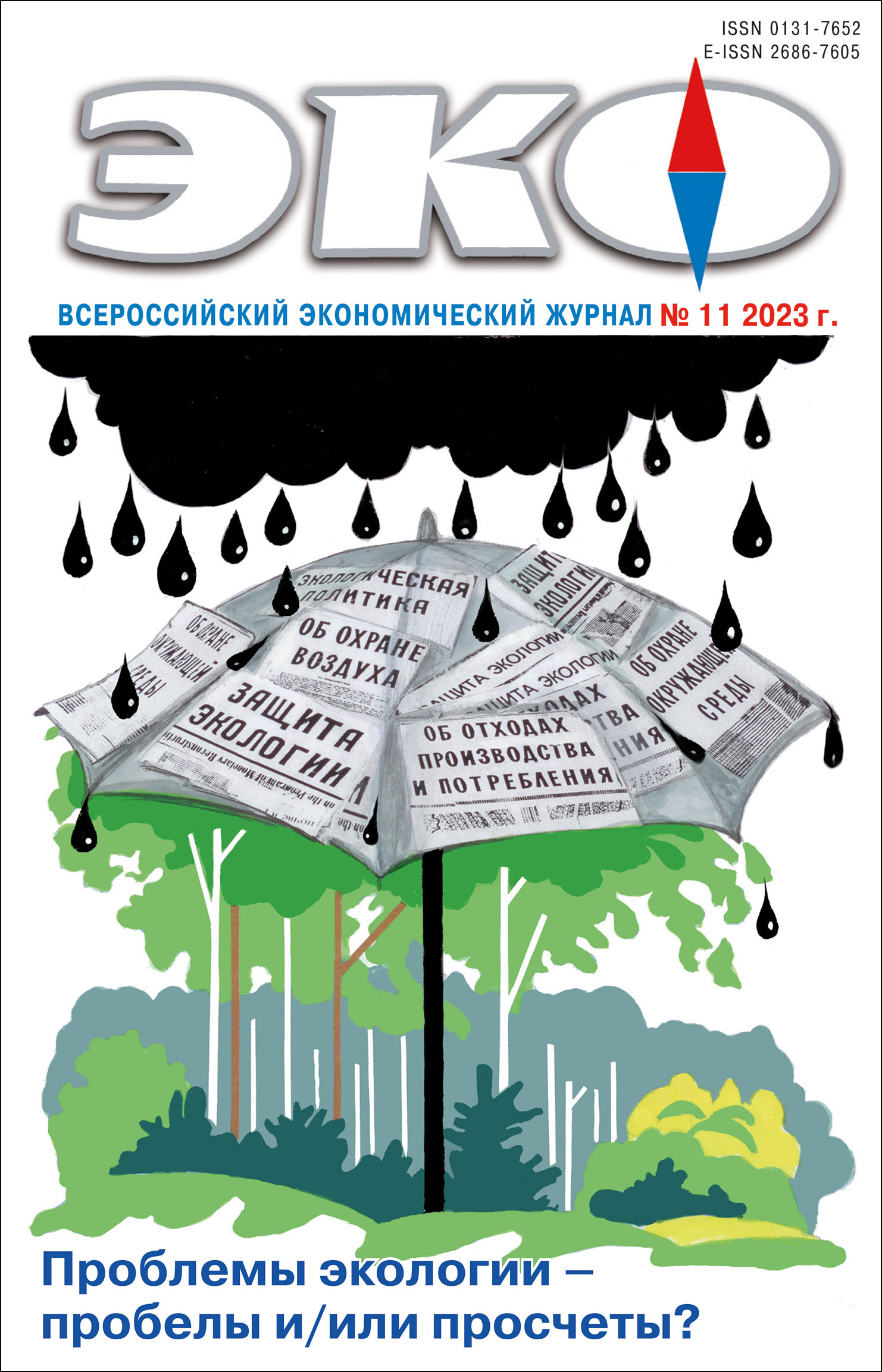Cover story: Ecological Problems – Gaps and/or Lapses
How to Overcome the Disparity between Strategic Planning and Environmental Policy of Russia?
Published 2023-10-27
Keywords
- measuring of economic growth; measuring of economic progress; gross domestic product; sustainable development; real savings; depletion of natural capital; public policy
How to Cite
1.
Pyzheva Ю. How to Overcome the Disparity between Strategic Planning and Environmental Policy of Russia?. ECO [Internet]. 2023 Oct. 27 [cited 2026 Jan. 8];53(11):8-24. Available from: https://ecotrends.ru/index.php/eco/article/view/4675
Abstract
The economic mainstream considers natural resources a limiting factor of economic growth along with labor and capital. At the same time, gross domestic product remains the principal indicator of economic progress, improvement of the population’s welfare and the benchmark of macroeconomic policy, which takes into account neither environmental nor social consequences of economic growth. The paper shows the rupture between the imperatives declared by strategic planning documents and the environmental policy actually implemented in Russia. The necessity of introducing an additional macroeconomic indicator – an integral indicator of sustainable development – into the socio-political agenda and strategies of socio-economic development of the country’s regions is substantiated. Such a maneuver would make it possible to create a system of sustainable development monitoring included in the process of strategic decision-making and contribute to achieving a more harmonious ratio between economic development and environmental degradation.References
- Бобылев С.Н., Зубаревич Н.В., Соловьева С.В. Вызовы кризиса: как измерять устойчивость развития? // Вопросы экономики. 2015. № 1. С. 147–160. DOI: 10.32609/0042–8736–2015–1–147–160
- Глазырина И.П. Тернистый путь к «зеленой» экономике// ЭКО. 2020. № 9. С. 8–23. DOI: 10.30680/ЕСО0131–7652–2020–9–8–23
- Жихаревич Б.С., Прибышин Т.К. Стратегии развития городов: российская практика 2014–2019 гг. // Пространственная экономика. 2019. Т. 15. № 4. С. 184–204. DOI: 10.14530/se.2019.4.184–204
- Забелина И.А., Делюга А.В. Геоэкологические индикаторы устойчивого развития: пространственный анализ // Устойчивое развитие горных территорий. 2019. Т. 11. № 1 (39). С. 15–25.
- Климанов В.В., Казакова С.М. Особенности стратегического планирования развития Дальнего Востока России на федеральном уровне // Региональные исследования. 2022. № 1. С. 68–79. DOI: 10.5922/1994–5280–2022–1–6
- Клисторин В.И. Эволюция стратегического планирования макрорегионов РФ // ЭКО. 2023. № 7. С. 21–38. DOI: 10.30680/ECO0131–7652–2023–7–21–38
- Крюков В.А. Не стратегия, но декларация // Наука в Сибири. 2023. № 7 (16 февраля). С. 7.
- Михеева Н.Н. Стратегия пространственного развития: новый этап или повторение старых ошибок? // ЭКО. 2018. № 5. С. 158–178. DOI: 10.30680/ЕСО0131–7652–2018–5–158–178
- Пыжев А.И., Сырцова Е.А., Пыжева Ю.И., Зандер Е.В. Совершенствование статистики устойчивости развития российских регионов // Вопросы статистики. 2019. Т. 26. № 5. С. 33–42. DOI: 10.34023/2313–6383–2019–26–5–33–42
- Пыжева Ю.И., Лапо Е.В., Сырцова Е.А, Пыжев А.И. Устойчивость развития регионов Дальнего Востока: оценка на основе истинных сбережений // Регион: экономика и социология. 2020. № 2 (106). С. 198–224. DOI: 10.15372/REG20200209
- Пыжева Ю.И., Зандер Е.В. Социально-экономическое разнообразие моногородов Сибири и Дальнего Востока: статистический анализ // Проблемы развития территории. 2019. № 3 (101). С. 49–61. DOI: 10.15838/ptd.2019.3.101.3
- Рюмина Е.В. Экологические аспекты оценки качества жизни // Экономика региона. 2016. Т. 12. № 4. С. 1113–1122. DOI: 10.17059/2016–4–13
- Сырцова Е.А., Пыжев А.И., Зандер Е.В. Истинные сбережения регионов Сибири: новые оценки, старые проблемы // ЭКО. 2016. № 6 (504). С. 109–129. DOI: 10.30680/ECO0131–7652–2016–6–109–129
- Тулохонов А.К. О Стратегии социально-экономического развития Сибири: риски, проблемы, решения // ЭКО. 2023. No 7. С. 8–20. DOI: 10.30680/ECO0131–7652–2023–7–8–20
- Тулохонов А.К., Михеева А.С., Бардаханова Т.Б. Еще раз о Национальной программе социально-экономического развития Дальнего Востока // Пространственная экономика. 2020. Т. 16. № 4. С. 165–179. DOI: 10.14530/se.2020.4.165–179
- Широв А.А. Статистика в интересах экономики и общества // Проблемы Прогнозирования. 2020. № 1 (178). С. 5–9.
- Cobb, C. (1994). The green national product: a proposed index of sustainable economic welfare / Clifford W. Cobb, John B. Cobb, Jr.: with contributions by Carol S. Carson … [et al.]. Human Economy Center. P. 325.
- Cook, D. (2021). An appraisal of interlinkages between macro-economic indicators of economic well-being and the sustainable development goals. Ecological Economics. Vol. 184. No. 106996. DOI: 10.1016/j.ecolecon.2021.106996
- Costanza, R., Hart, M., Posner, S., Talberth, J. (2009). Beyond GDP: The Need for New Measures o Progress. Pardee Paper. No. 4, Boston: Pardee Center for the Study of the Longer-Range Future.
- Daly, H. (1990). Toward some operational principles of sustainable development. Ecological Economics. Vol. 2. Pp. l-6.
- Daly, H. (1992). Allocation, distribution and scale: towards an economics that is efficient, just, and sustainable. Ecological Economics. Vol. 6. Pp. 185–193.
- Morgan, J., Daly, H. (2019). The importance of ecological economics: An interview with Herman Daly. Real-World Economics Review (90). Pp. 137–154.
- Pyzheva, Yu., Lapo, E., Syrtsova, E., Pyzhev, A. (2021). Evaluation of Genuine Savings in the Russia’s Far East Regions. Regional Research of Russia. Vol. 11. No. 1. Pp. 121–128. DOI: 10.1134/S2079970521010111
- Seliverstov, V., Melnikova, L. (2013). Analysis of strategic planning in regions of the Siberian Federal District. Regional research of Russia. Vol. 3. No. 1. Pp. 96–102. DOI: 10.1134/S2079970513010097
- Stiglitz Joseph, E., Sen, A., Fitoussi, J.-P. (2010) Mis-measuring Our Lives: Why GDP Doesn’t Add Up. The New Press.

